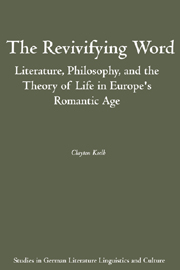Book contents
- Frontmatter
- Contents
- Preface
- Note on Abbreviations and Translations
- Part I Letter and Spirit
- Part II The Dead and Living Past
- 3 “The Heavenly Revelation of Her Spirit”: Goethe's The Sorrows of Young Werther
- 4 “O Read for Pity's Sake!”: Keats's Endymion
- 5 “Graecum Est, Non Legitur”: Hugo's Notre-Dame de Paris
- 6 “Spiritual Communication”: Gautier's Spirite
- Part III The Incarnate Word
- Conclusion
- Works Cited
- Index
3 - “The Heavenly Revelation of Her Spirit”: Goethe's The Sorrows of Young Werther
from Part II - The Dead and Living Past
Published online by Cambridge University Press: 05 February 2013
- Frontmatter
- Contents
- Preface
- Note on Abbreviations and Translations
- Part I Letter and Spirit
- Part II The Dead and Living Past
- 3 “The Heavenly Revelation of Her Spirit”: Goethe's The Sorrows of Young Werther
- 4 “O Read for Pity's Sake!”: Keats's Endymion
- 5 “Graecum Est, Non Legitur”: Hugo's Notre-Dame de Paris
- 6 “Spiritual Communication”: Gautier's Spirite
- Part III The Incarnate Word
- Conclusion
- Works Cited
- Index
Summary
ALTHOUGH GOETHE'S NOVEL The Sorrows of Young Werther (Die Leiden des jungen Werther, 1774) is one of the most famous and most highly praised works in all of German literature, one of its principal climactic scenes almost always bores or mystifies modern readers almost to the point of ruining their pleasure in the story. It is a scene of reading. Werther arrives at Lotte's house unexpectedly, after the two had an agreement that they would have to keep apart from each other. It is to be their last meeting together, for Werther will commit suicide the next night by shooting himself in the head “above the right eye, driving his brains out” (GS 127; GW 124). Only the reader, but not Lotte nor anyone else, knows that Werther has resolved to die, but everyone concerned knows that the two young people will not see each other again. At this peak of emotional intensity, the lover and his beloved do not do anything like we would expect: they do not profess love to each other, they do not lament their fate, they certainly do not make love, and in fact actually speak very little to one another. Instead they read together a lengthy passage from Werther's translation of “Ossian,” the heroic Irish poet so popular in Goethe's youth who turned out later to be a hoax perpetrated by the bard's alleged “translator,” James MacPherson.
- Type
- Chapter
- Information
- The Revivifying WordLiterature, Philosophy, and the Theory of Life in Europe's Romantic Age, pp. 47 - 67Publisher: Boydell & BrewerPrint publication year: 2008



